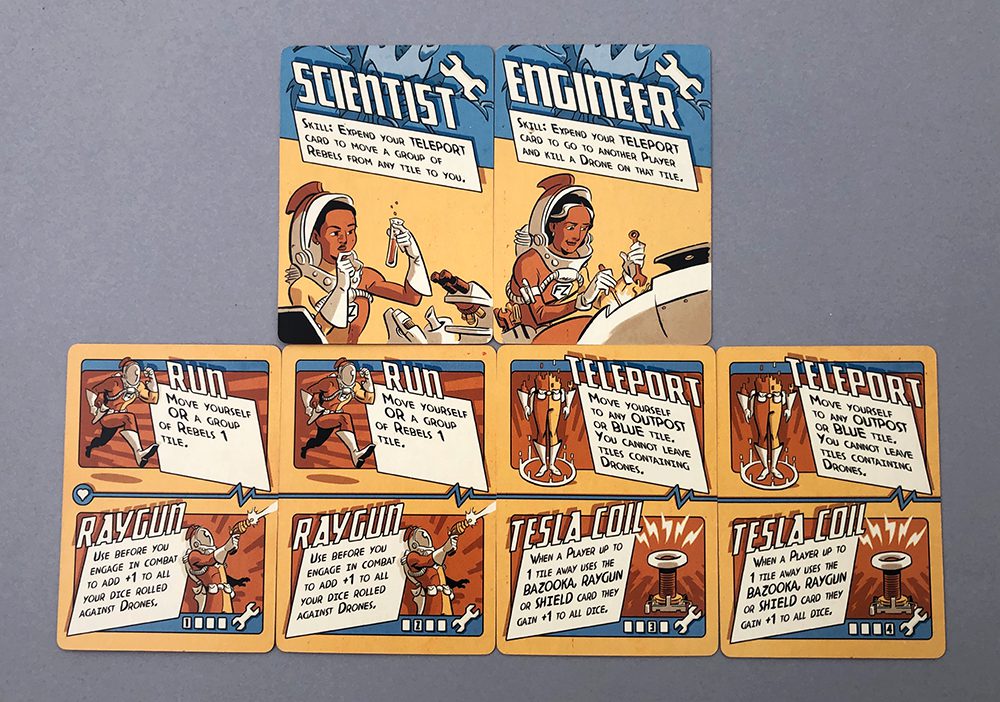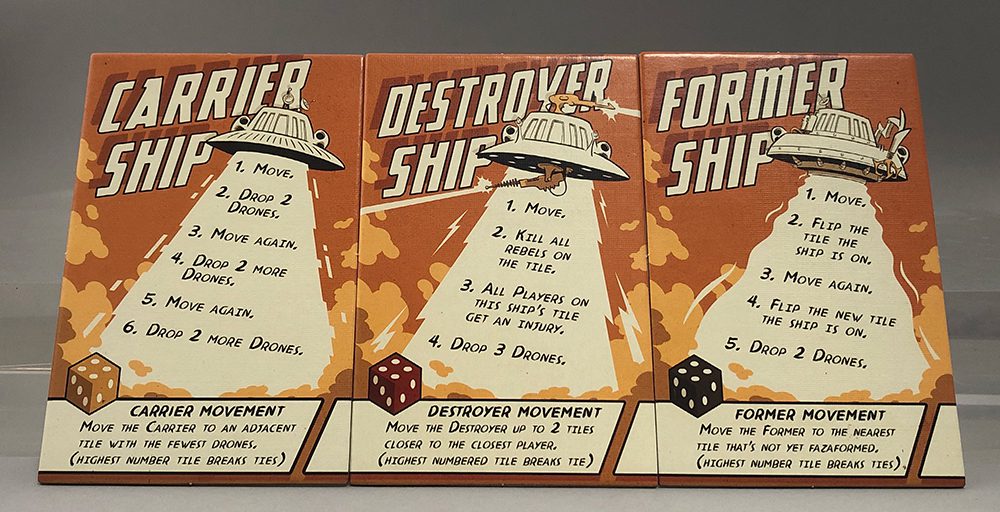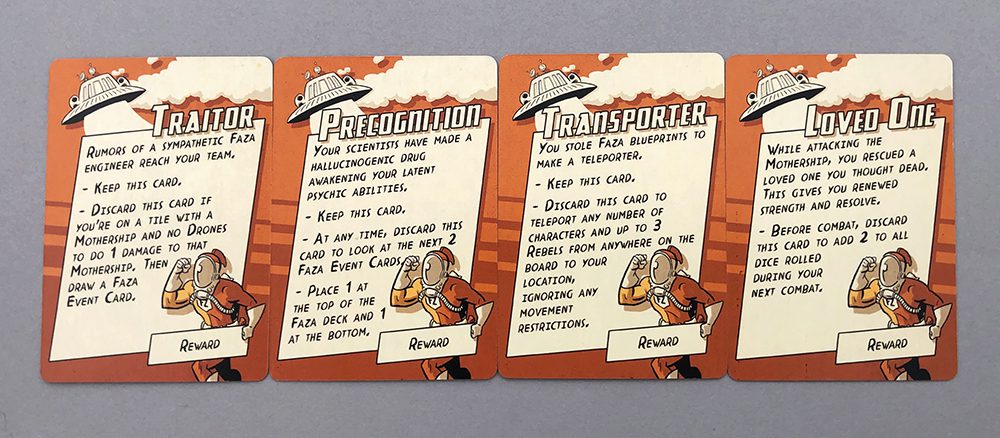Intro
In the future while humans are busy Terraforming Mars, the Faza are Fazafying Earth!
In 1895, H.G. Wells asked the question “What would the world look like if we found ourselves being invaded by a superior species from a different planet?” Over the next two years he set about answering that question in the best way he knew how, through the magic of fiction. His effort would go on to become what is arguably his most famous work, The War of the Worlds.

In the ensuing centuries, the concept of a group of rag-tag defenders fighting off an invading species has become a popular trope. Sometimes humanity puts aside its petty squabbles and comes together to bravely stave off disaster (Harry Turtledove’s alternate history science fiction Worldwar series, for example) . Other times humanity loses horribly (Pierre Boulle’s Planet of the Apes). Sometimes humans are the aggressors (James Cameron’s Avatar). It’s such a popular trope that it was only a matter of time before it found its way into board games.
Faza isn’t the first, but it is one of the most recent in a long line of board games that have explored the theme. In Faza, a group of beings called, you guessed it, the Faza are invading Earth. Their method of attack is to use fighter drones to eliminate all resistance and then terraform, sorry, Fazaform the host planet to make it more habitable for them and less so for whatever unfortunate beings happen to already live there. Who knows how often they’ve done this before? All we know is that this time around, they picked the wrong planet. Humanity isn’t going down without a fight.
If you’re just interested in finding out what we think of Faza, feel free to skip ahead to our discussion. If you’d like to know more about how the game is played, then read on!
Setup
The setup for a game of Faza is pretty simple. First, the 16 Board tiles are shuffled and placed face up in a random 4 x 4 arrangement.

The tile numbered 16 is turned face down to its “Fazaformed” side. One of the Motherships is placed onto this tile with the black die cradled inside a space at the top and set to a number determined by the players’ chosen difficulty.

For example, in Normal difficulty, each Mothership die starts at 4. The other two Motherships and their accompanying dice, brown and yellow, are set onto the tiles numbered 15 and 16 respectively. Each Mothership will spawn orange Drones onto its own tile and the tiles orthogonally adjacent to it. No tile in the game may ever contain more than 3 Drones or 3 Rebels (which we’ll talk about shortly) at any given time. So it is entirely possible that one Mothership’s drone placements may cancel out a portion of another’s.

Players then choose from four different sets of Occupations, matched by a specific color, each with its own special ability and set of action cards. While these can be drawn randomly, it can be helpful in your early games to review the special abilities of these cards and select two Occupations that complement one another.

Next, each player takes their matching colored pawn.

Pawns start on the Outpost that matches their color (numbered 1-4 on the tiles) and start with two purple Rebels on their Outpost.

Players take the six cards that match the color of their pawn. Two of these cards represent the options for their character’s Occupation/Special Abilities in the game. If they haven’t done so already, players then select one of these and flip the other card to its opposite side. (The reverse side is a convenient Player Aid for turn actions.)
The remaining four cards are laid out side by side in ascending numerical order. These cards describe each player’s unique actions and represent their health pool.

When a player sustains an injury the Healthy card furthest to the left is turned over to the Injured side where the abilities are significantly weakened.

Then the Faza Event card deck is shuffled and placed face down close by along with the extra supply of Rebels and Drones and the 3 white dice. Close to this the 3 Mothership Guide tiles are placed face up in a row in alphabetical order.

The Mothership Activation Tracker (which we’ll refer to as the “MAT”) is placed on top of the Carrier Ship tile and you’re ready to begin.
Do you have what it takes to defend the planet against the Faza scourge?!
Anatomy of a Round
A round of Faza consists of 2 distinct phases: the Team Phase (in which the players work together to try to wipe out as many Drones and/or Motherships as possible) followed by the Faza Phase (in which the Faza, unsurprisingly, retaliate). Faza is played over multiple rounds until one of the end game conditions is met. These end conditions are:
- Any one of the players loses all of their health: a loss for the entire team.
- The last Outpost tile gets Fazaformed: a loss for the entire team.
- There are no more drones to place into the playing area when you are asked to do so: a loss for the entire team.
- All Rebels have been removed from the board (Hard mode): a loss for the entire team.
- All 3 Motherships are defeated: a win for the entire team.
As you can no doubt see, things are heavily skewed towards the players losing, so it’s going to take good teamwork if you want to succeed.
While the Team Phase comes first, how you choose to act is heavily influenced by what will happen in the Faza Phase, so let’s look at that first.
The Faza Phase
The odds of victory may seem small but fortunately for the players, they’re not flying completely blind. Each Mothership has a prescribed series of actions that it will perform during the Faza Phase. One will perform its move, followed by the next in alphabetical order (wrapping back around to the beginning once you’ve reached the end of the alphabet), followed by the next, etc. As each completes its turn, the MAT is moved to the right to the next Mothership in line. This continues until a number of ships have taken their turn equal to the player count.
Knowing which Motherships are going to be moving next, where they’ll be moving to, and what they’ll be doing is key to developing a strategy that will let you successfully navigate Faza’s pitfalls and hopefully claim victory. So let’s take a quick look at their actions.
Here’s a two-player game set up on Normal Mode.

The Carrier Mothership, in the upper left corner with the yellow die, will move to the nearest adjacent tile with the fewest Drones, with the larger number on a tile breaking any ties. As all movements are orthogonal, this means the Carrier Mothership will move down to Tile 11. Instead of dropping two Drones, it can only drop one on that tile (since a tile can only hold up to three Drones). Then it will move to the right to Tile 6 since it is the closest tile with the fewest Drones. It drops only one Drone there bringing the Drone total on Tile 6 up to three. For its third and final move, it moves up to Tile 9 where it can only drop a single Drone. Tile 1 is also next to Tile 6 and contains the same number of Drones as Tile 9, but since 9 is higher than 1, it breaks the tie.
Now let’s take a look at the Destroyer Mothership on the same board.

The Destroyer Mothership moves up to two tiles towards the closest player. In this case it would simply move to Tile 1 where the Green player is. It would drop a single Drone and deliver an immediate injury to the Green player.
Green, being aware of this, needs to plan their moves so they end their turn out of danger. How far would that be?

The reach of the Destroyer Mothership shouldn’t be underestimated.
The Former Mothership, seen on the lone Fazaformed tile, would move twice, Fazaforming each tile. It always moves to the closest tile that hasn’t already been Fazaformed with the highest numbered tile breaking any ties.

The Former Mothership will flip the two tiles indicated. On its next turn, Tile 4 and Tile 9 will be Fazaformed.
The Team Phase
This is the phase where everything happens. In this phase, there is no set turn order. The players can do whatever they like in any order they like so long as they have the ability to do so. On a player’s turn they can do any one of a number of things:
- Move using one of their movement cards. Any cards used by the player during their turn are turned sideways to denote they’ve already been used.
- Use a power up provided by one of their cards (if they have any). These power ups are used to assist the player during combat. Speaking of which…
- Combat Drones that are on the same tile as the player. We’ll go into more detail about combat momentarily.
- Utilize Rebels to attack a Mothership. This will also be talked about during the combat discussion.
- Use a card to heal themselves or another player (if they possess such a card).
- Heal a damage if the player is at an Outpost (combat, once again).
- Trade in 2 defeated Drones to recruit a Rebel which can be placed onto any of the Outposts.
If the team agrees, players can even take multiple turns in a row. Once the players have nothing else they can or want to do, the Faza Phase begins.
Drone Combat
Combat. Time to bust out your inner Will Smith and punch some aliens in the face! This is where you watch your flawless plans succeed beyond your wildest dreams or come crashing down in flames.
A single round of combat consists of a single roll of the dice equal to the number of Drones present on the tile and you can engage in combat as often as you like. So, if there are 3 Drones on the same tile as your pawn, then you’ll roll all 3 white dice. Each die that comes up 4, 5, or 6 is a success and a Drone is removed from the card and placed into your player area as a collected “point”. Anything below a 4 will result in a damage done to you… unless there’s a Rebel present. Each Rebel on your tile can take 1 damage for you. Rebels sacrificed in this way are removed from the playing area and returned to the supply. If there aren’t any Rebels present, though, and you haven’t used a power up to prevent damage done to you during this round of combat, you’ll receive 1 point of damage for each low number rolled. Damage taken this way is represented by flipping over one of your cards to its damaged side. If all four are ever flipped at the same time, then you’re dead and your team loses the game.
Thankfully, damage isn’t permanent. If you ever find yourself on an Outpost, then you can exhaust one of your damaged cards to flip it over to its healthy side. Or, if you’re lucky, another player has a Heal ability in their card roster and will use it on you.
And it’s worth mentioning that a player can never move out of a space in which Drones are present. Combat is unavoidable. There are no pacifists in Faza.
Mothership Combat
Mothership combat is an entirely different beast, though, and follows several rules. For starters, unless you’ve used a power up that lets you bypass this rule, you must be on the same tile as a Mothership to even begin thinking about attacking it. Secondly, the tile must be empty of Drones. And, thirdly, you don’t attack the Mothership yourself. Instead, you convince a Rebel to do it. This means, as you have no doubt surmised, there must also be at least 1 Rebel present.
If you’ve met all of these criteria, then you can remove a Rebel to the supply and decrease the Mothership’s health by 1 by turning its die to one pip lower in value. If the Mothership only had 1 health left, then you have defeated it. Its cardboard token is removed from the game, and its Guide tile is flipped over to its defeated side. Just because it’s gone doesn’t mean it isn’t going to keep doing annoying things on its turns. Presumably you’re fighting Mothership ghosts at that point?

After you’ve reduced each Mothership’s health by one, the top card of the Faza Event deck is flipped over and the text printed on the card is carried out.

This is almost always detrimental to the players and will frequently result in at least 1 or 2 Drones being placed onto the tile. Some events take place instantly and are discarded as soon as the card has done its damage. Some will remain active until the next Faza event is revealed. Still others linger until the players collectively expend enough points to remove them from play. There are a few helpful events, but these are few and far between.

And that’s it. That’s all there is to playing Faza. Plan. Attack. Defend. Over and over until you either win or lose.
What We Think
David: When I first got my copy of Faza in the mail, I was immediately taken with the artwork. It reminds me of early ‘50s MAD Magazine when it was still in its original comic book format. The orange overtones lend the artwork a very pulpy feel and the retro style of the artwork seals the deal. I really like the way that Faza looks. If I had to find one complaint about the artwork it would be that there isn’t enough of it. The front of the box is very detailed and action packed and I was hoping to see more of that once I started playing the game, but I was disappointed to see that there wasn’t. The Board tiles are sparsely illustrated and the Faza Event cards even less so, an illustration of the same ship in one corner and then either a Faza or a player character in the other. I would have loved to see illustrations that actually depicted the text on the cards.
Tom: Faza wins the Best Thematic Artwork for a Board Game in 2020 for me. Illustrator Scott Chantler has done an amazing job of creating comic book sci-fi suspense and horror with his line art. Given that his color pallet is fairly limited, it’s even more impressive. Add in the arcing comic book-style font (not Comic Sans, thank goodness) and you have a great looking design. Serious kudos for the mix of genders for the various occupations, too! Going through the rule book and the player cards I was really looking forward to Faza hitting the table.
Unfortunately, when it hit the table, there wasn’t much to look at. The 16 land tiles that make up the board were a big disappointment. I know they’re supposed to represent attacked and Fazaformed land, but there was still a lot to work with there if they had chosen to do so. The tiles look, well, dull and unimaginative. (We still don’t get why Tile 16, which always starts the game off Fazaformed, has a ‘regular’ artwork side that will never be used.) Also, points off for the game being very color-blind unfriendly.
The graphic designer of the rule book made good use of Chantler’s illustration. As well, the book is well-designed and easy to read. The unfortunate thing is that we ran into several questions in our first game that were not answered within the text of the rule book. While I know a rule book cannot account for all possibilities, the questions we had were not dealing with minutiae.
One other important point here, though, is that Benjamin Farahmand, the game’s designer, is active on the BGG Forums for the game and even offered to speak with me over the phone or via Zoom to make sure we understood the answers to our questions. That truly impressed me.
David: I still remember how differently our first game together turned out versus our most recent play through. Our most recent game ended in a crushing defeat. We got too greedy and took a gamble that ultimately didn’t pay off. That first time, though, was a cakewalk and it certainly raised a lot of questions. It didn’t help that the rule book wasn’t able to answer those questions and that we had to go to the BGG Forums to get some definitive answers. To echo what you’ve already said, it’s an attractive, well laid out rule book, but it isn’t a great one. Also, if I’m being honest, we played a lot of stuff completely wrong and that’s 100% on us.
Tom: And we played some of those things wrong because they weren’t clear in the rule book.
David: Okay. So maybe it’s more like 87% on us!
Tom: One of the things that concerns me about the lack of player turn order is that it opens up the game to Quarterbacking — the tendency for one player to become dominant and dictate all of the moves in a co-op game to work out a plan of their own devising. I’m very careful to play co-ops with people who all respect one another and are there for the fun of the game. It would be helpful if the rules explicitly stated that a player has final say over the actions their character takes during a given Team Phase.
David: It’s worth mentioning that this never cropped up in any of the games we played together, but that can probably be chalked up to us being experienced players. Also, we usually wound up agreeing that the strategy we wanted to put into place was the best one. That’s partially due to the way the Motherships move and also just due to us being experienced board gamers.
Tom: Who both like and respect one another.
David: Speak for yourself. 😉
Tom: It’s the long hair. Go ahead and admit it. : )

Tom: Speaking of Motherships, one of the problems I had with the Mothership Phase is the way in which they engage and move. You know at the start of your Team Phase which Motherships are going to move in their round, how many times they may engage. While this means your team can work out a strategy for what they need to try and accomplish during their Team Phase and where they need to be/not be at the end of their turns, it made things a bit too predictable for me. I think how the tension that happens at the end of each player’s turn in Pandemic when you don’t know which cities will be drawn for infection is missing from Faza. Or the card-driven, randomized way in which Trogdor, the Archers, and Troghammer move in Trogdor! The Burninator. Maybe it’s just me, but the Motherships felt more like a predictable nuisance than a deadly problem.
David: I agree with you somewhat. The unpredictability comes in the form of the card draws that resulted from attacking the Motherships. There was one game we played where you only had 2 health left and the Mothership only had 1. We could have decided to leave it alone and focus on getting somewhere safe for you to heal, but we decided to go for broke and try to take it out and the card flip did us in. While I was never particularly worried about the Motherships, I was always worried about the card draws.
The random element in Faza that doesn’t sit right with me are the dice rolls. I hate rolling dice.
Tom: I hate combat that’s dice-driven. (It’s one of the reasons I’m not a fan of Risk.) It negates any planning I’ve done to get me to that point. (It’s another reason why I love Abstracts: No Dice)
David: Insert off-topic “Input versus output randomness” conversation here. I’m team input, by the way. I wish that Faza had us rolling a pool of dice and then assigning the results to various tasks (kind of like the dice are handled in Lorenzo il Magnifico) instead of just wishing and praying that things go our way. Like you said, the combat in this game feels like it negates everything else that we did during the turn… all of our planning, teamwork, and clever maneuvering are just rendered moot by a bad toss of the dice.
I will say, though, that one of Faza’s greatest strengths is that it got us talking. There wasn’t a single round where we weren’t discussing the pros and cons of various decision trees. I really enjoyed that part of the experience.
Tom: Was that Faza itself, or the way we would play any co-op game?
David: I think it’s more to do with Faza and less to do with how you play cooperative games. I’ve played worse cooperative games; games that were way too easy (Forbidden Island comes to mind) where the best move to make was always fairly obvious and I’ve played games that were so insanely difficult that the decisions you make hardly matter (I’m talking about you, Ghost Stories). For me, Faza falls somewhere in between. It’s definitely skewed more towards the Forbidden Island side of the scale, but it does succeed at engaging everyone at the table.
Tom: Pandemic and Burgle Bros. always spark discussion for me. It’s part of why I tend to like co-op games.
I guess it’s inevitable that I would then compare Faza to those other co-ops. For me, Faza was… okay. Not great, not bad. Still, I don’t foresee it getting played nearly as much as any of my other co-ops. It’s just sad that the actual game didn’t live up to the stellar artwork.
David: I think we’ve said pretty much all there is to say about Faza. While it certainly isn’t the strongest cooperative game I have ever played, it does have some teeth. I wouldn’t ward people away from it either. We’ve talked about co-ops in one of our Board Game Step Ladders before. If I tried to fit Faza onto that ladder, I’d say that it sits somewhere between Forbidden Island and Pandemic. I think it would serve as an excellent link between the two. It’s a bit more challenging than Forbidden Island mechanically, but it’s not as difficult as Pandemic. The game plays relatively quickly, too, so there’s that. And, also, did I mention that it looks great? I can’t stress that enough. Faza’s one of the best looking games in my collection.

Tom: I think there’s one more thing to say, and that’s about Faza’s price point.
David: Oh, yeah. That.
Tom: You can buy Faza from TheFaza.com, but it’s going to set you back $50.
David: It definitely doesn’t feel like a $50 game. Compare it to something like Terraforming Mars, a game that is so packed with components that it’s a struggle to close the box and sells for $10 less on Amazon, and the value just doesn’t seem like it’s there.
Tom: Or Agricola. Honestly, at $50.00 I have a hard time recommending it.
David: As a thought experiment, what would be a price point you’d feel good about that could make you more likely to recommend the game? And, if the game were at that price point, would you recommend it?
Tom: Something closer to the $25 price range seems more reasonable for what’s inside the box. My recommendation would be tempered somewhat, but the whole win-or-lose-by-a-dice-roll aspect of the game just isn’t for me. I want to play against the game, not the game and some dice.
David: Price point aside, if I were judging the game solely on its merits as a game, Faza would score maybe a 7 out of 10. The random dice combat outcomes don’t sit well with me, but that’s just how I am as a gamer. A big portion of that 7 score is the artwork and the game’s ease of play. I think it’s the kind of co-op game that my parents could understand and grasp and they are definitely not the same breed of gamer as we are.
Tom: I’d give it a 5 out of 10. I like the art, but I’m not playing the art, I’m playing the game. The Drone and Rebel meeples are cool but, again, they’re not the game. If there was another way to combat the Drones other than dice rolling and if the Motherships’ movements were at least partially randomized, I’d be a bigger fan.
David: So there you have it folks: Faza. Hopefully we’ve given you the information you need to make an informed decision if you’re thinking about adding it to your collection.











Add Comment